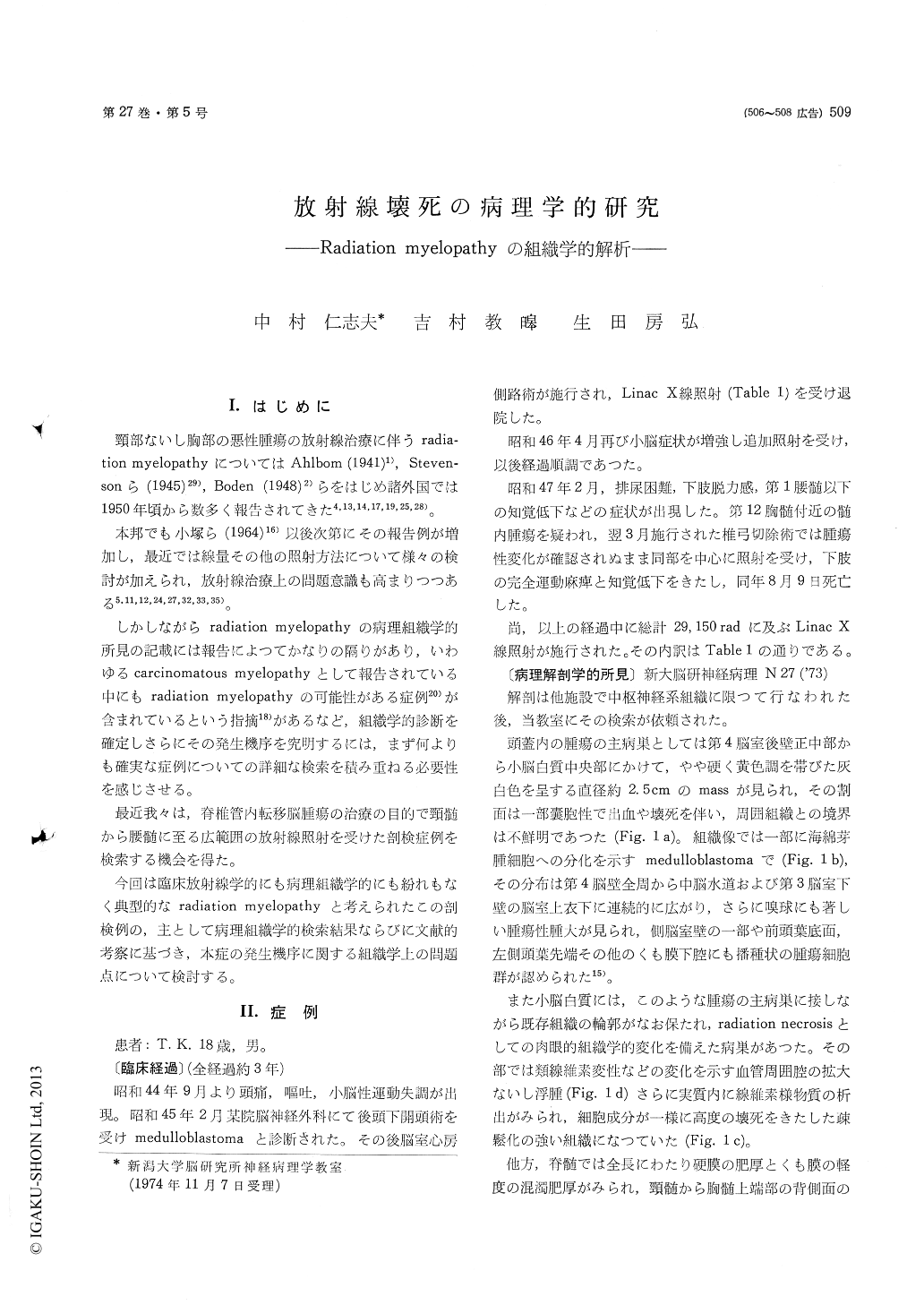Japanese
English
- 有料閲覧
- Abstract 文献概要
- 1ページ目 Look Inside
I.はじめに
頸部ないし胸部の悪性腫瘍の放射線治療に伴うradia—tion myelopathyについてはAhlbom(1941)1),Steven—sonら(1945)29),Boden(1948)2)らをはじめ諸外国では1950年頃から数多く報告されてきた4,13,14,17,19,25,28)。
本邦でも小塚ら(1964)16)以後次第にその報告例が増加し,最近では線量その他の照射方法について様々の検討が加えられ,放射線治療上の問題意識も高まりつつある5,11,12,24,27,32,33,35)。
Pathoanatomical changes of an irradiated case of18-year-old male who had suffered from cerebellarmedulloblastoma with subarachnoid spread werereported.
A large amount of Linac X-ray dose had beenirradiated to the brain and spinal cord of the case,to wit: 14,450 rads to the lower thoracic segmentsand more than 7,400 rads to the lumbar segments.
The main tumor was located at the roof of the4th ventricle and disseminated along the ventricularsystem, in the basal cistern and olfactory bulbs.However, the caudal invasion was limited to thesubarachnoid space of the cervical spinal cord, andno tumor cell dissemination was detected macro-and microscopically in the thoracic and lumbarsegments.
The following macro- and microscopic findingsled us to consider that this case showed a typicalhistology of radiation myelopathy, even thoughthere could not be found amyloid material whichhad been sometimes described to be one of thespecific findings of radiation necrosis of the centralnervous tissue.
Macroscopically, there was no remarkable changein volume and consistency of the thoracic andlumbar cord. But the elasticity was highly di-minished and the cut surfaces were somewhatyellowish-whitish colored and fragile at the lowerthoracic segments. Under the microscope thosesegments revealed extensive coagulation necrosisin which complete disintegration of myelin andaxon, no survived cell element except a few ghost-cell-like neurons, and the vascular changes wereobserved.
The vascular changes were more prominentlyfound in the smaller blood vessels, such as hyalinousthickening, concentric cleavage or fenestration andfibrinoid degeneration of vessel walls, adventitialfibrosis and edema of perivascular spaces of smallarteries, fibrin thrombi of occulusion of arteriolesand capillaries, as well as telangiectasia of smallveins and venules with slight perivascular hem-orrhage of cell infiltration. Additionally, slightirregular thickening or swelling of the intimas weredetected in the trunk and main branches of theanterior spinal artery and vein.
In the lumbar spinal cord, moderate neuronaldegeneration and protoplasmic astrocytosis were ob-served even through population of the neurons wasrelatively well-preserved in the anterior and post-erior horns. The posterior white column showedsevere rerefaction in spite of minimal neuronaldegeneration in the lumbar spinal ganglia and onlyslight demyelination in the posterior nerve roots.
The changes in the lumbar posterior white col-umns were considered not to be only a secondarydegeneration but also to be a primary lesion causedby irradiation. And also ascertained was the factthat the spinal ganglia and nerve roots were fairlyradioresistent.
Liquefactive necrosis in the gray matter of thecervical cord was considered not to be of radiationmyelopathy but of nonspecific circulatory disturb-ance, because of the absence of such vascularchanges as above described and the presence ofcompound granule cells etc. This supposition wasalso supported by small quantities of irradiated dosein the clinical data.
As for the vascular changes, they were thoughtto be very important findings in histological di-agnosis of radiation myelopathy. And it was sup-posed that increased permeability of the blood vesselwalls played an important role to some extent incausing coagulation necrosis. Although the res-ponsibility of venous circulatory disturbance hasbeen also discussed in literatures, there were no de-finite indications observable relative to whether anyinclination existed between the arterial and venoussides in intensity of the vascular changes in thiscase.
As for the discrepancy between the resistency ofthe myelin of the spinal cord and of nerve roots,it was supposed to be resulted from radiosensitivityof oligodendroglia and of Schwann cells.
However, why the coagulation necrosis was oftennoted in a restricted zone of cerebral white matterand why the above described remarkable vascularchanges were restricted to the area of coagulationnecrosis alone, but not in the surrounding irradiatedarea, are remained obscure.

Copyright © 1975, Igaku-Shoin Ltd. All rights reserved.


